If any ancient city benefited from its privileged location, it was Corinth. Paired with a gorgeous coastal setting and the natural resources to be successful, it became an economic superpower and one of the greatest cities of Classical and Roman Greece.
The story of ancient Corinth is as rich as its ruins. All saturated in one area, you’ll find a mythical and legendary city, a famous canal, an impressive acropolis, a shrine center devoted to healing, and the Isthmian Games sanctuary. And, since the Apostle Paul made three visits to Corinth and lived there for almost two years, I was eager to investigate!
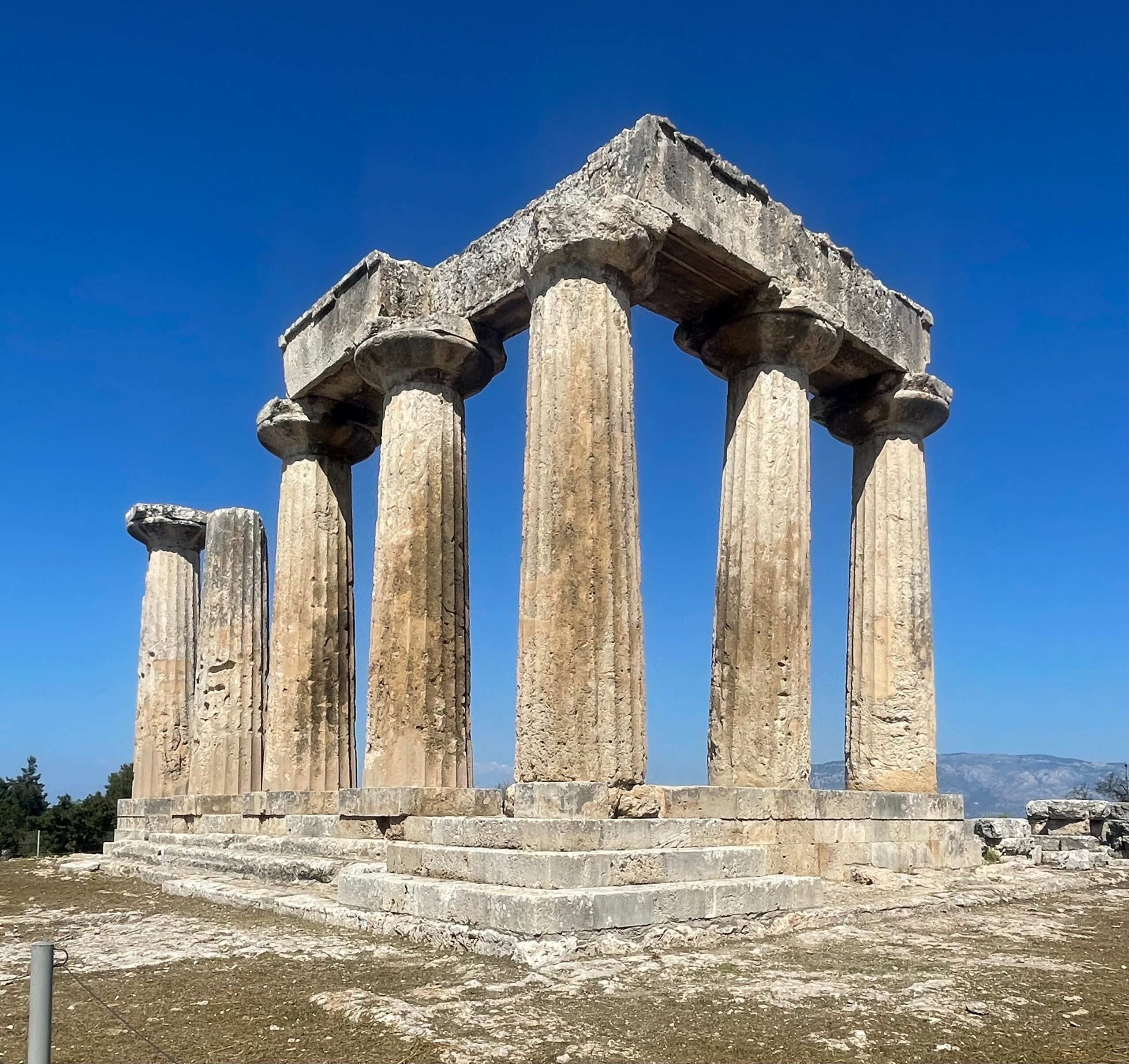
The Temple of Apollo
Today, ancient Corinth is a working archaeological site about three miles from modern Corinth, and it sits at the top of the Peloponnese on an isthmus.
You can visit Corinth easily with a tour group OR travel solo by car, train or bus. It’s less than two hours from Athens. We had a rental car and chose to explore at our own pace.
So, what's an Isthmus?
Corinth’s isthmus is a narrow piece of land (like a bridge) which connects mainland Greece to the Peloponnese. It’s about four miles across and links the Saronic Gulf (Aegean Sea to the east) and the Gulf of Corinth (Ionian Sea to the west). If not for the isthmus, the Peloponnese peninsula would be an island.
In ancient times, anyone crossing into the Peloponnese had to travel through Corinth, and Corinth controlled the isthmus and its ports. The tiny land bridge was crucial for protection, and it was the key trade route connecting Italy to the west and Asia Minor to the east. On each side of the isthmus were two of the busiest seaports in the world.
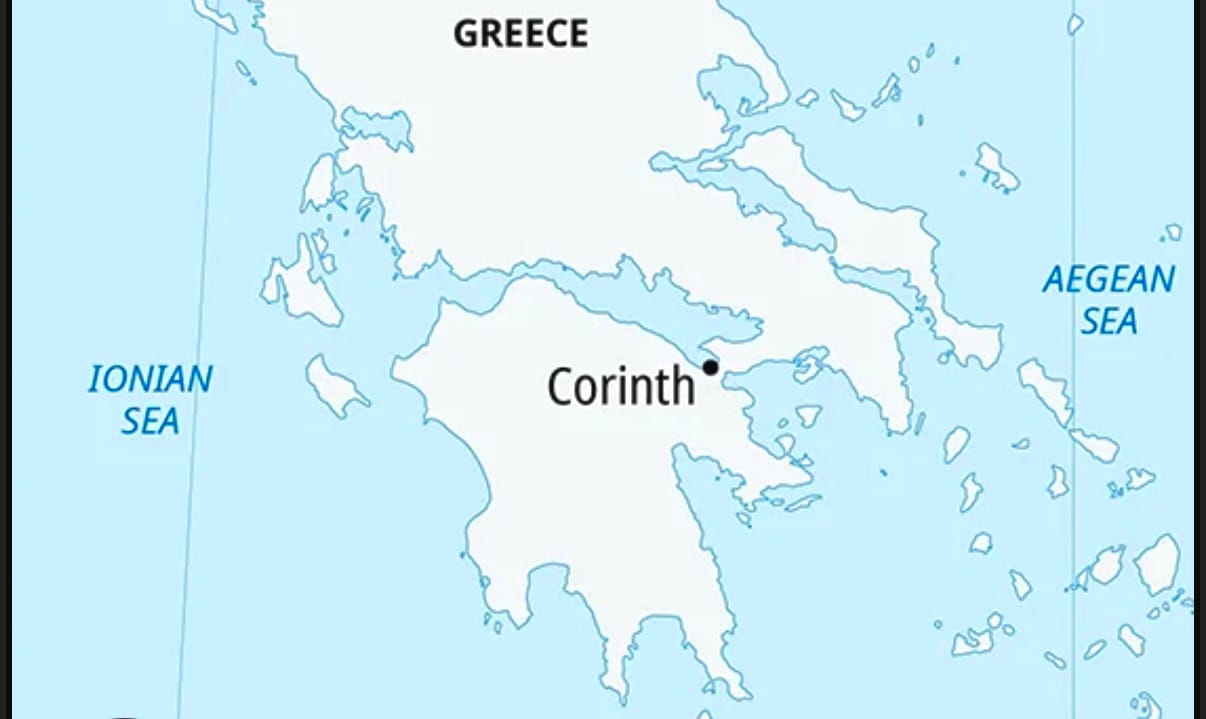
Ships avoided traveling all the way around the Peloponnese. It added an extra 200 dangerous miles at sea. And because of winds from the north and treacherous currents, sailors bragged if they were lucky enough to survive it twice.
But Corinth provided a solution! In the 6th century BC, Corinth’s ruler Periander invented a transportation option for merchant and war ships to cross the isthmus with a movable wooden platform, called a Diolkos.
The Diolkos and Dreams of a Canal Shortcut
The Diolkos platform (or sled) was between 10-20 feet wide and could cross the isthmus in two grooves about four feet apart.
It allowed small boats and supplies from entire ships to be moved between the two ports on rollers using ropes and lots of man-power. Large or heavy ships still had to unload cargo to be hauled over the diolkos; then they would make the hazardous trip around the Peloponnese.
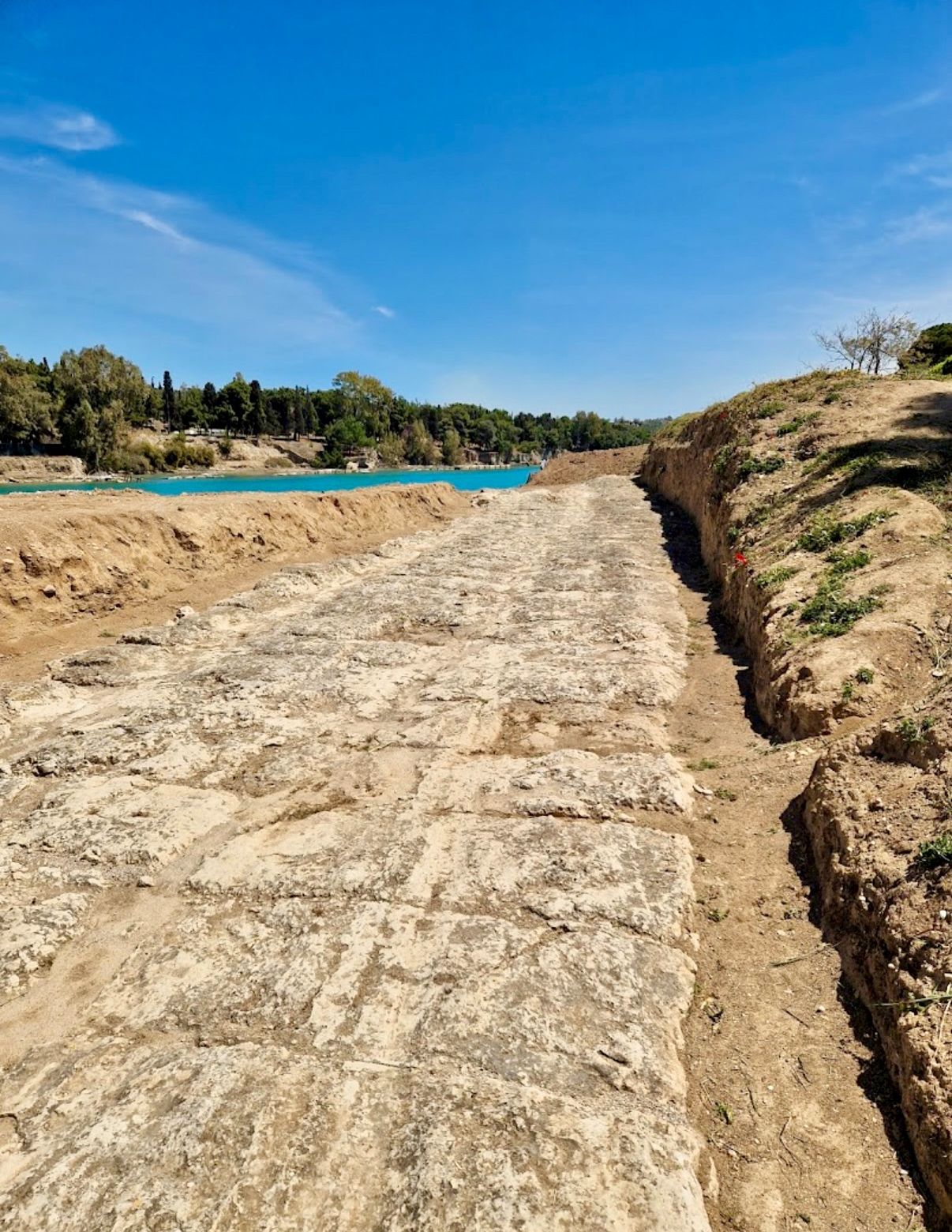
An excavated portion of the Diolkos
The diolkos solution made Corinth rich. Tolls from goods entering Corinth’s ports accounted for nearly all government revenues. And while ships were waiting in line for cargo to be unloaded and moved over the diolkos, Corinth provided a city for trade, commerce, and entertainment.
They benefited from travelers, merchants, sailors, soldiers, and Isthmus Game athletes spending their money in town. And they made them use Corinthian coins.
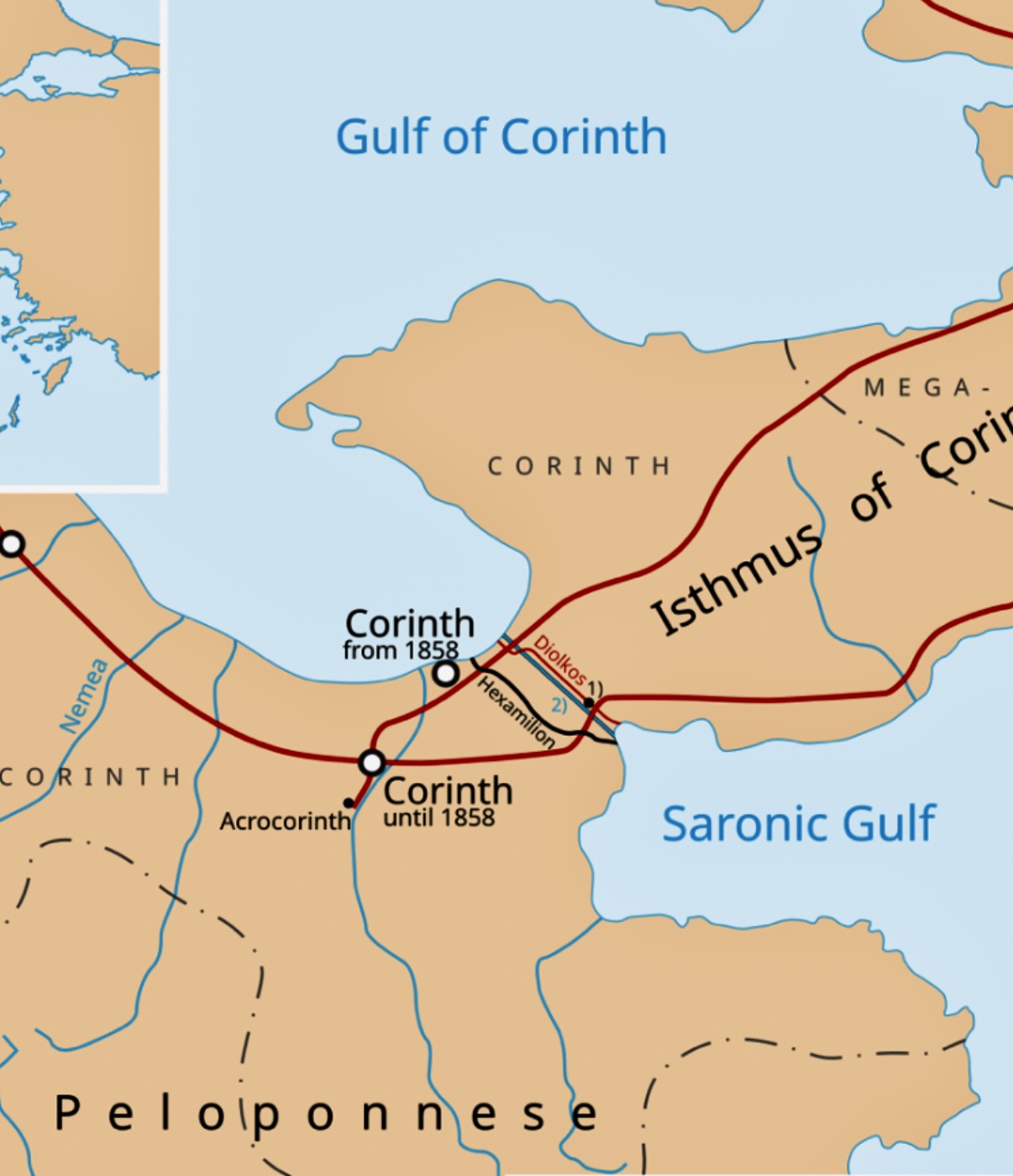
For centuries, countless rulers dreamed of carving a canal through the narrow isthmus. When Julius Caesar was assassinated in 44 BC, his plans were stopped before digging began. In 40 AD, engineers put the project on hold declaring all of Greece would be flooded if they cut through the isthmus.
Roman Emperor Nero broke ground for a canal in 67 AD. After the Jewish revolt in Galilee (Israel) against the Romans, Nero put 6000 Jewish prisoners on the job. But they hit granite bedrock after three months of digging, and the project shut down after Nero’s assassination.
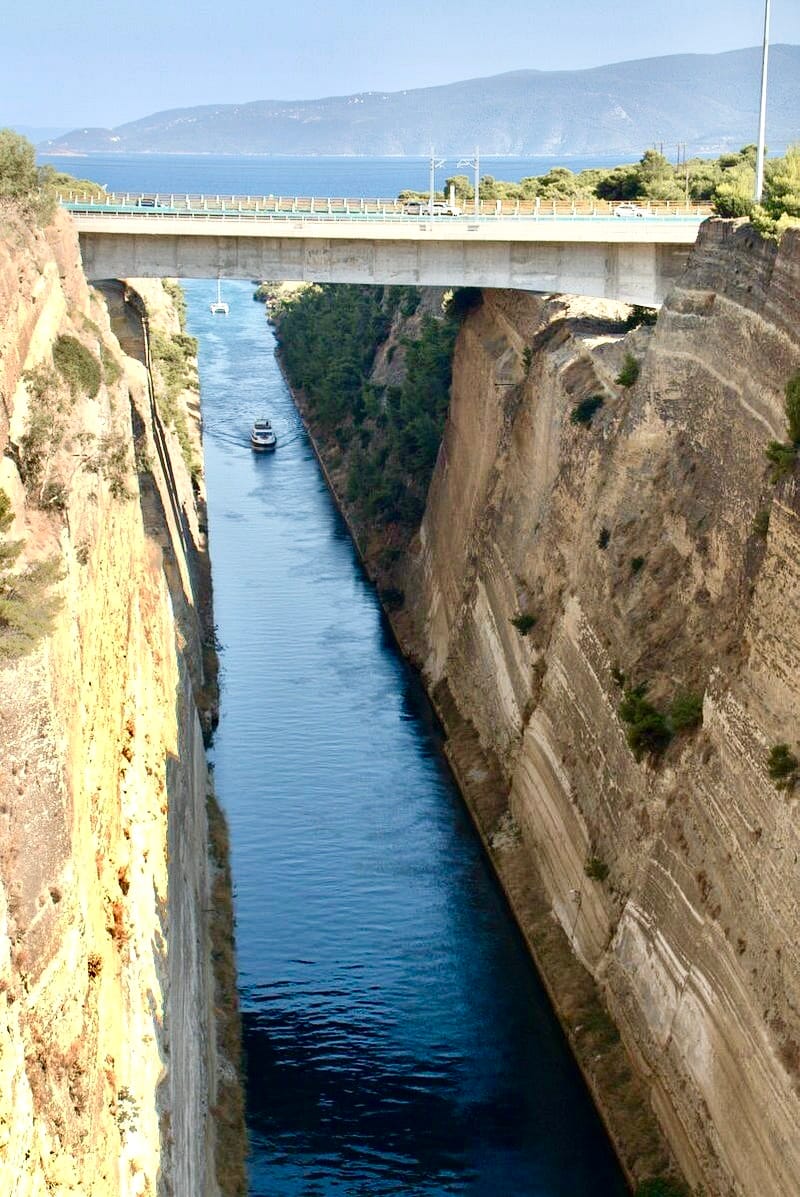
Corinth Canal
After 2500 years of failed attempts, the Corinth Canal (1882-93) was finally completed in 1893 by cutting through 285-feet of rock to sea level.
Today, tourists can speed right over the busy canal on their way to the Peloponnese or stop and see this remarkable feat of engineering. We did!
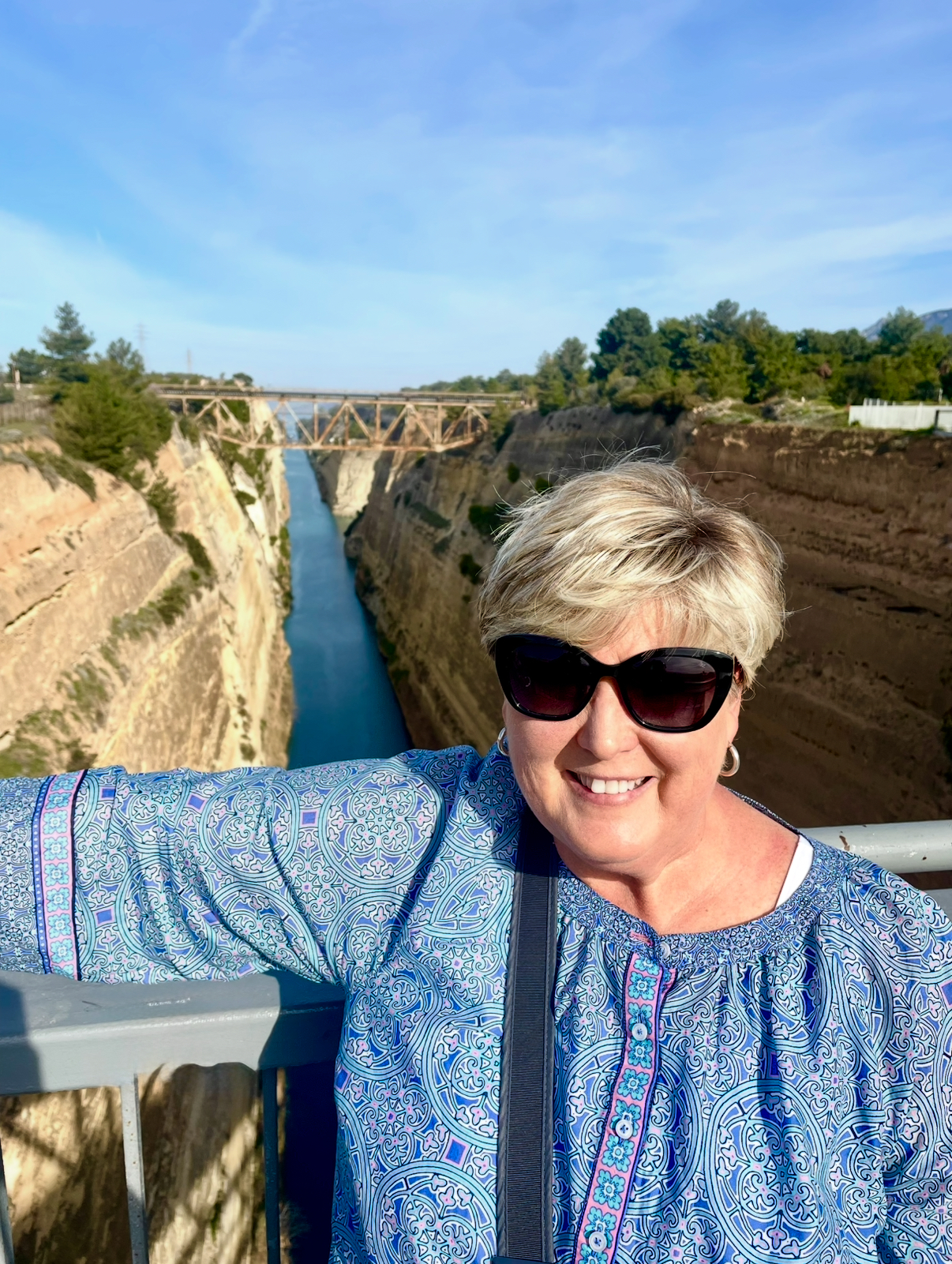
Turning Points in Corinth's History
As early as 4000 BC, a colony was established in the area where the Temple of Apollo sits now. Despite continuous earthquakes and invasions, Corinth survived and developed commercially. They believed Corinthus was Zeus’ son and named the city after him.
From 1600 to 1100 BC, Corinth prospered from its seaports. In 1000 BC, Dorians from the north took over and expanded trade by establishing “daughter city” colonies like Corfu and Syracuse.
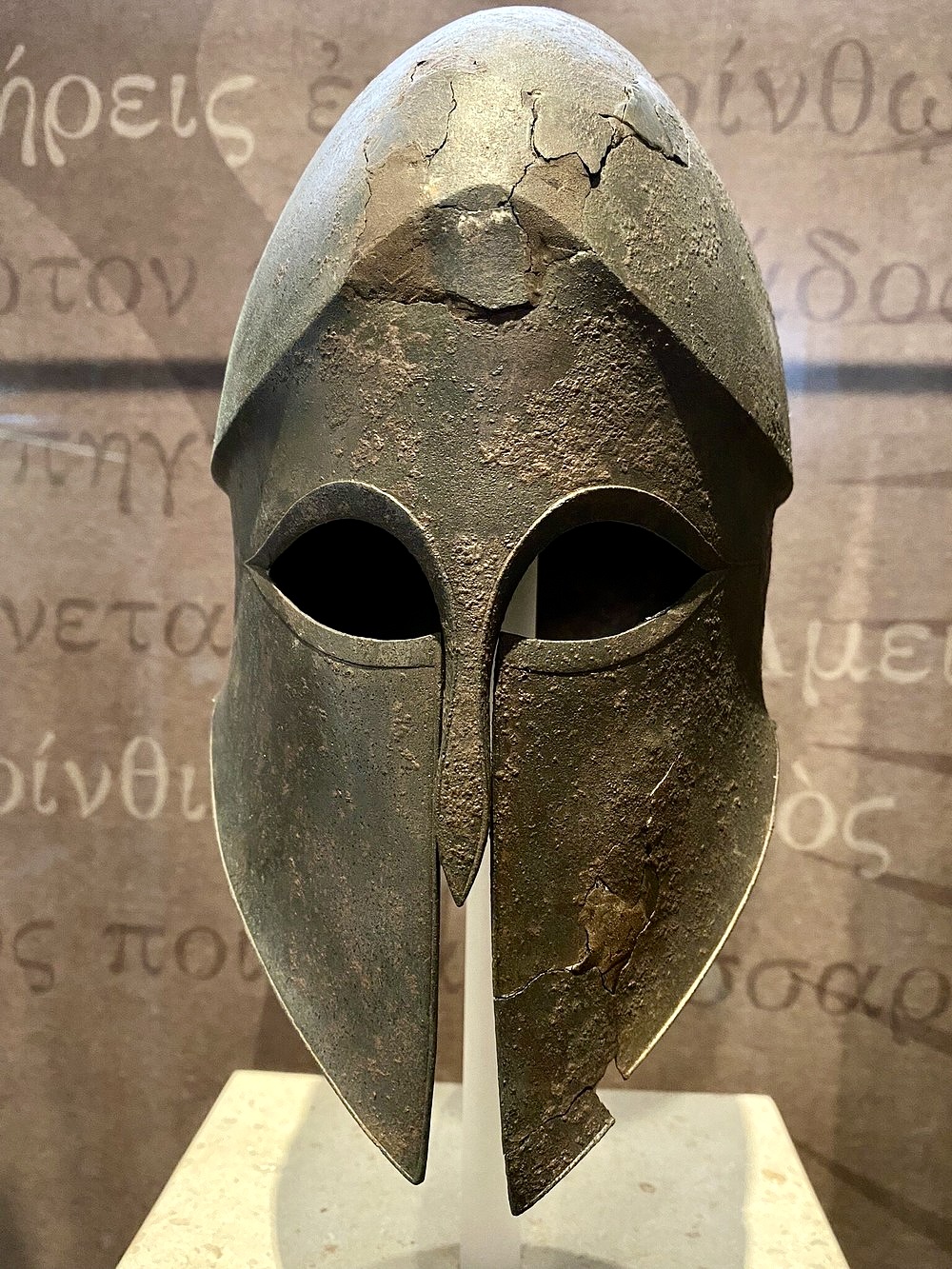
As ships delivered products worldwide from Corinth, their military grew stronger too. Around 700 BC, they perfected the Trireme naval warship, and it ruled the Mediterranean.
Corinth was overthrown in 657 BC by Cypselus, who ruled for 30 years until his son, Periander took over. The city prospered from Periander’s extensive construction projects and commerce. They produced and exported bronze helmets, terra cotta pottery, and copper vessels.
When a new corrosion-resistant alloy made of copper, gold, and silver was created, Corinthian Bronze became all the rage, and everyone in the world wanted it!
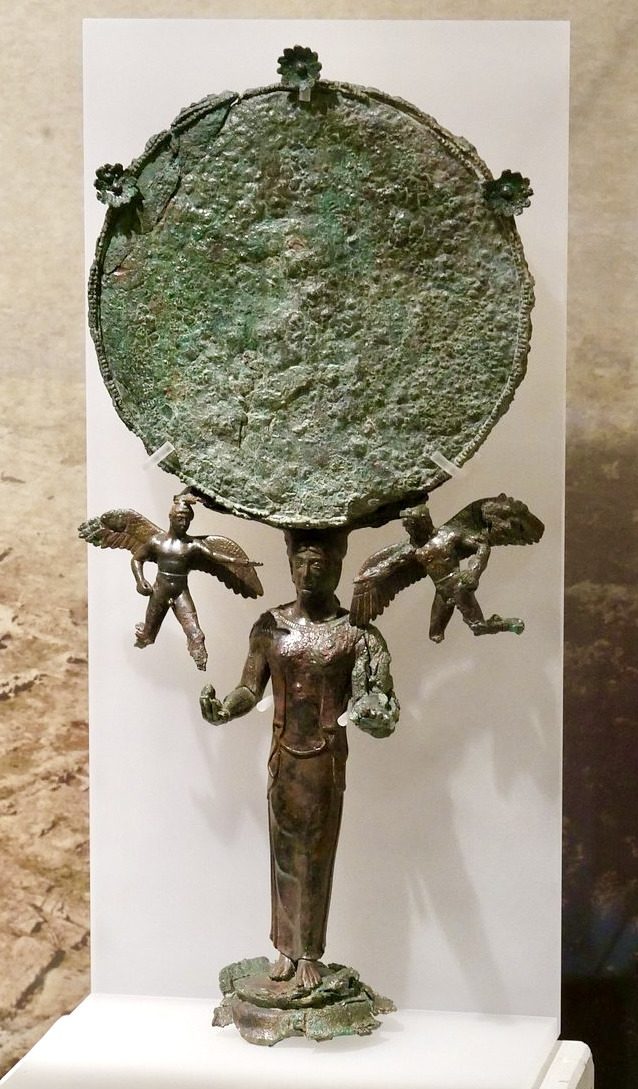
Corinthian Bronze Mirror – Corinth Museum
The Temple of Apollo was completed in 540 BC. By 400 BC, Corinth was one of the largest Greek cities with 90,000 people. King Philip of Macedon (father of Alexander the Great) conquered Corinth in 338 BC and made it the center of the Hellenic League.
Corinth led the fight against Roman occupation. But in 146 BC, the Romans invaded, killed everyone or took them as slaves, and left the city deserted for 100 years. Julius Caesar re-founded Corinth in 44 BC. And once again, it thrived.
After Rome, Corinth had a revolving door of rulers: the Byzantines, Franks, Venetians and Ottomans. A bubonic plague, plus earthquakes in 522 and 551 AD started its decline. Finally, Corinth was destroyed by a massive earthquake in 1858.
The Acropolis - What's Up There?
If they ever feared being attacked, Corinth had a defense plan. Just above the city was an even higher up acropolis, or fortress, called the Acrocorinth. If they had to flee to higher ground, several springs could provide water for everyone–which kept them from being under siege.
Over time, Corinthians reinforced the Acrocorinth with medieval walls and monumental gates. They wisely dug a 3-mile-long tunnel from inside the second gate to a hidden location. The tunnel allowed them to sneak in and out for resources, food, and enemy information.
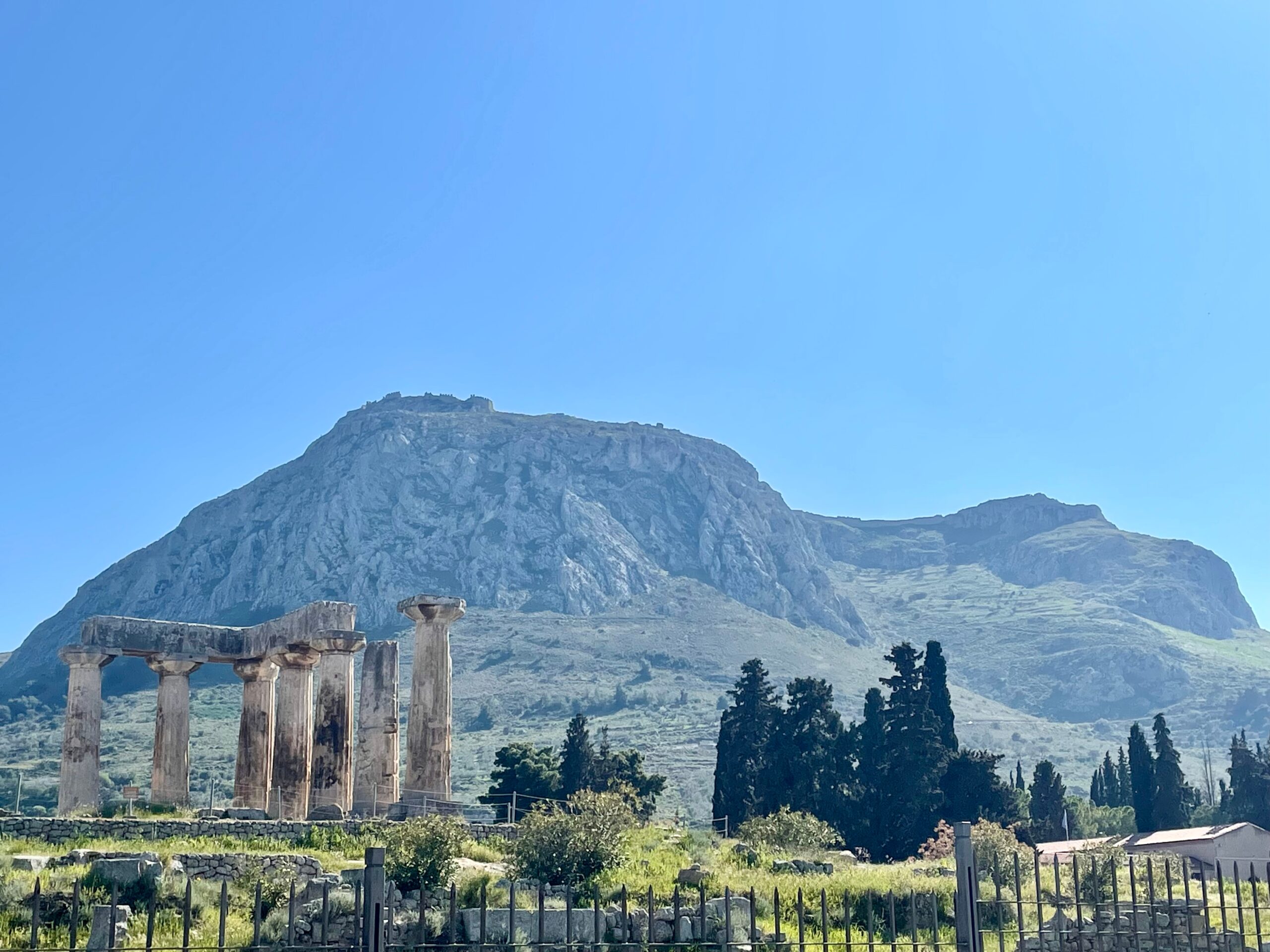
The Acrocorinth towered over the city.
For centuries, temples to Greek gods and cult sanctuaries lined the mountain road up to the top. On the lower mountain slopes, visitors can see the Sanctuary to Demeter and where Diogenes, the cynic philosopher, lived in a barrel.
Perched at the acropolis summit was the Temple of Aphrodite. It was well known for the more than 1,000 temple prostitute slaves who lived there and brought in funds for the Greek goddess of beauty. In its heyday, lustful locals and visitors made many trips up the mountain for pleasure.
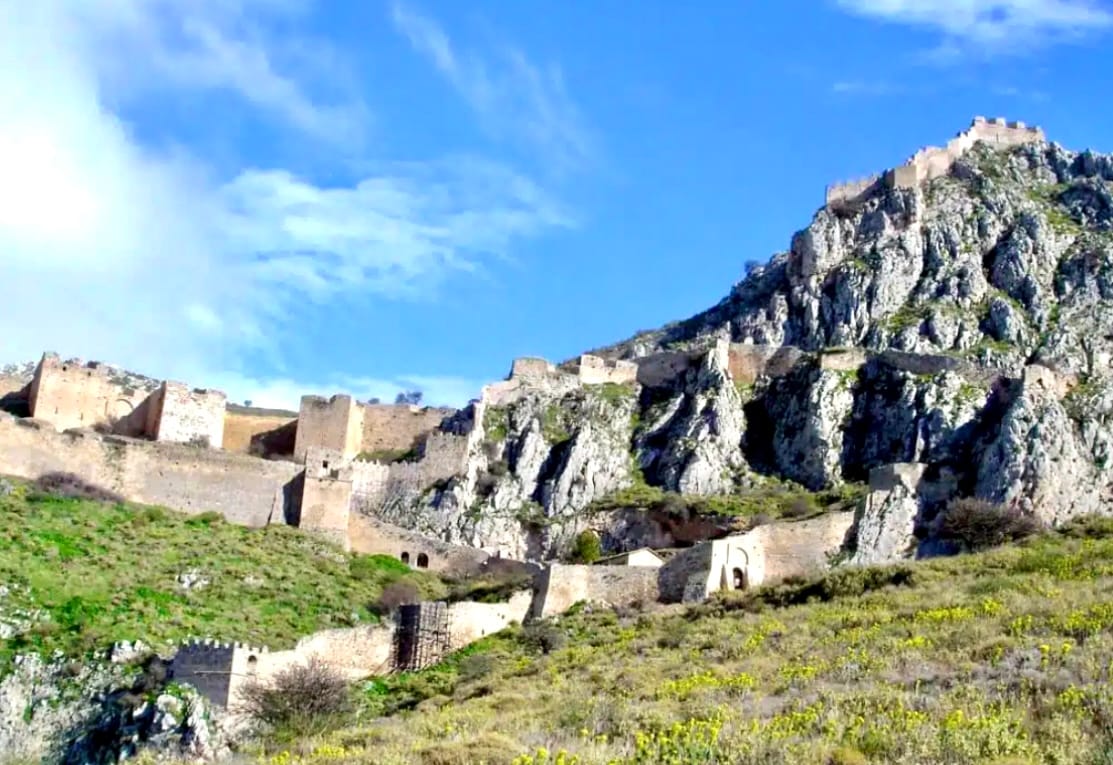
TIP: To explore the ancient fortress and castle, visitors can hike one-to-two hours to the top of the Acrocorinth or drive/taxi up to a certain point and hike another 10-15 minutes. Tour buses don’t go up the steep mountain.
The Isthmian Games
Every two years, the Panhellenic Isthmian Games were celebrated on the isthmus near Corinth. The games honored Poseidon, the mythical god of the sea, and they were one of the four major Panhellenic festivals along with the Olympic, Pythian, and Nemean Games.
My travel blogs for Olympic and Pythian Games: Olympia, Greece – The Birthplace of the Olympics and Delphi, Greece – It’s Still a Mystery
Isthmian Games began in 582 BC and were open to all Greeks, even women in Roman times. Competitions included foot races, boxing, chariot racing, wrestling, gymnastics, plus musical and poetry contests.
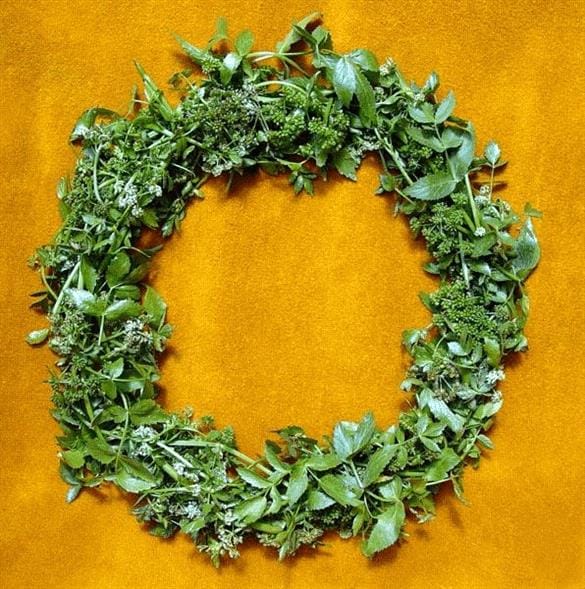
There were no gold medals. Victors were awarded a crown of wild celery–and in Roman times: a pine wreath.
Corinth’s economy was boosted from festival athletes, coaches, and spectators coming from all over the Greek world.
TIP: You can tour the Isthmian Games sanctuary, stadium, theater and hippodrome and visit the Archaeological Museum of Isthmia.
The Apostle Paul in Corinth
During his second missionary journey, the Apostle Paul arrived in Corinth around 50 AD and stayed for 18 months. From the Book of Acts, plus Paul’s letters to the Corinthians and Romans, we know he made three visits to Corinth.
Paul counted it a blessing to share the Gospel of Jesus wherever he went, and he established a Christian church in Corinth during his first stay.
Paul supported himself as a leatherworker–living and working at a shop for a tentmaker named Aquila. (Acts 18:2-3). Aquila, and his wife Priscilla, were a Jewish couple from Italy who ended up in Corinth after Emperor Claudius banished all Jews from Rome. They were also instrumental in helping Paul build the Corinth church.
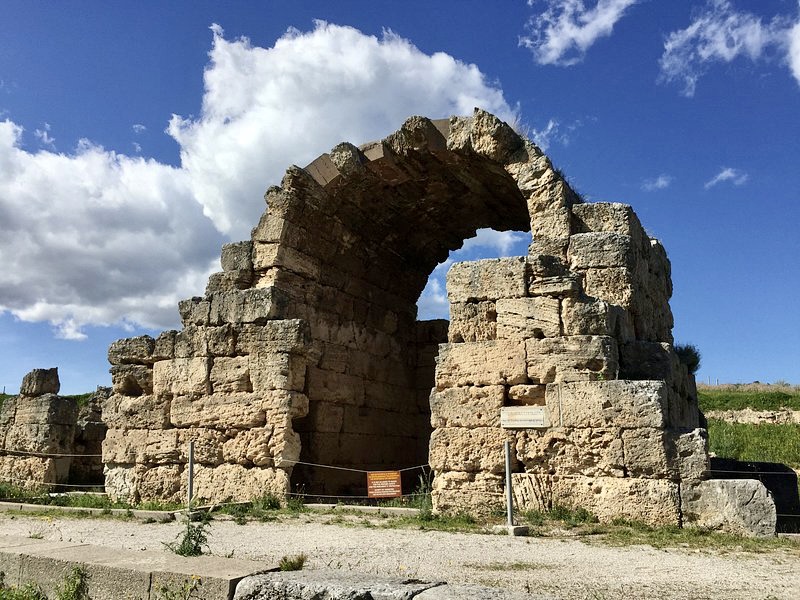
One of the 44 shops in the North Market. Owners lived in lofts above their shops. Hired workers, like Paul, would have lived and slept on the lower shop floor.
Tents were made of leather in the 1st century, so Paul’s trade skills were in demand. Sailors in port without permanent housing often stayed in tents, and thousands of people traveling to the 51 AD Isthmian Games lodged in tents around the sanctuary site.
Paul most likely witnessed some competitions as he made and repaired tents at the Isthmian Games site. Tent-making was apparently back-breaking work, and Paul wrote, “We grow weary from the work of our own hands.” (1 Cor. 4:12)
In the summer of 51 AD, some Corinthian Jews charged Paul with breaking several Jewish laws and illegally teaching. He was summoned to the Bema platform for judgment before Gallio, the Roman proconsul. Gallio heard from Paul, refused to judge religious disputes, and dismissed the charges.
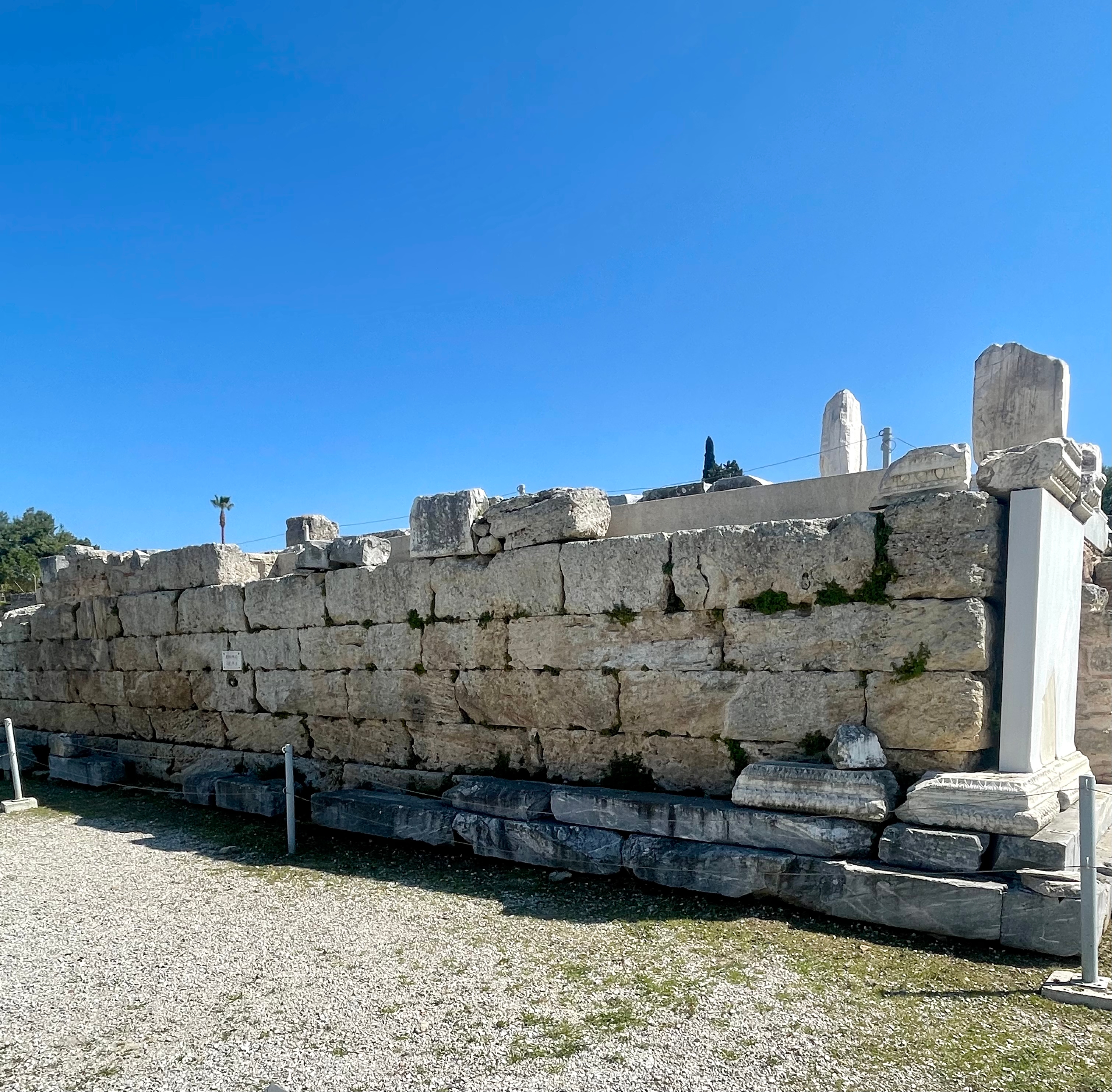
The Bema platform where Paul was judged and later wrote to Corinthians about judgment from God.
The Apostle Paul and the Corinthian Church
Paul had to adapt in each city he visited, and Corinth was no exception. As a Christ follower, he found ways to share the Gospel with people in the busy Corinth crossroads (from Jews in the synagogue, to Gentiles in the marketplace, and visitors wherever he worked).
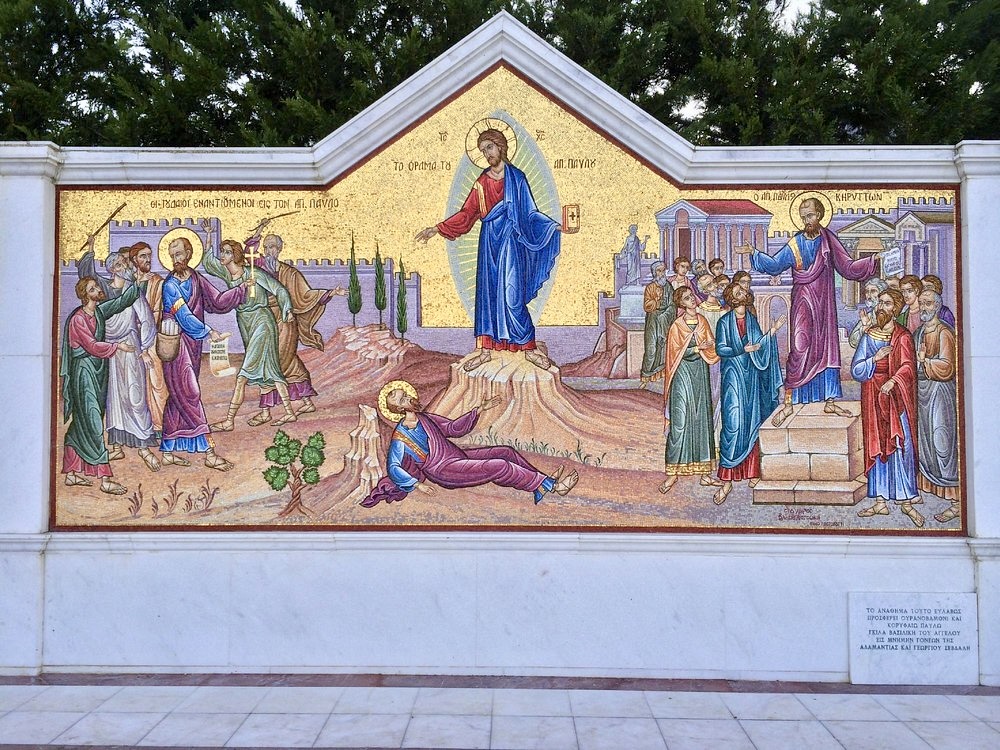
Mosaics depicting the life of the Apostle Paul near ancient Corinth.
Divisions within the church cropped up because of Corinth’s pagan culture and immorality. (1 Cor. 5:1-6:20). Paul not only returned to Corinth twice, he wrote two letters to the Corinthians to both encourage and chastise them. After visiting Corinth, I now understand why Paul brought up “temples” so often!
In his letters, Paul used athletic metaphors Corinthians would have understood from attending Isthmian Game foot races, wrestling and boxing matches.
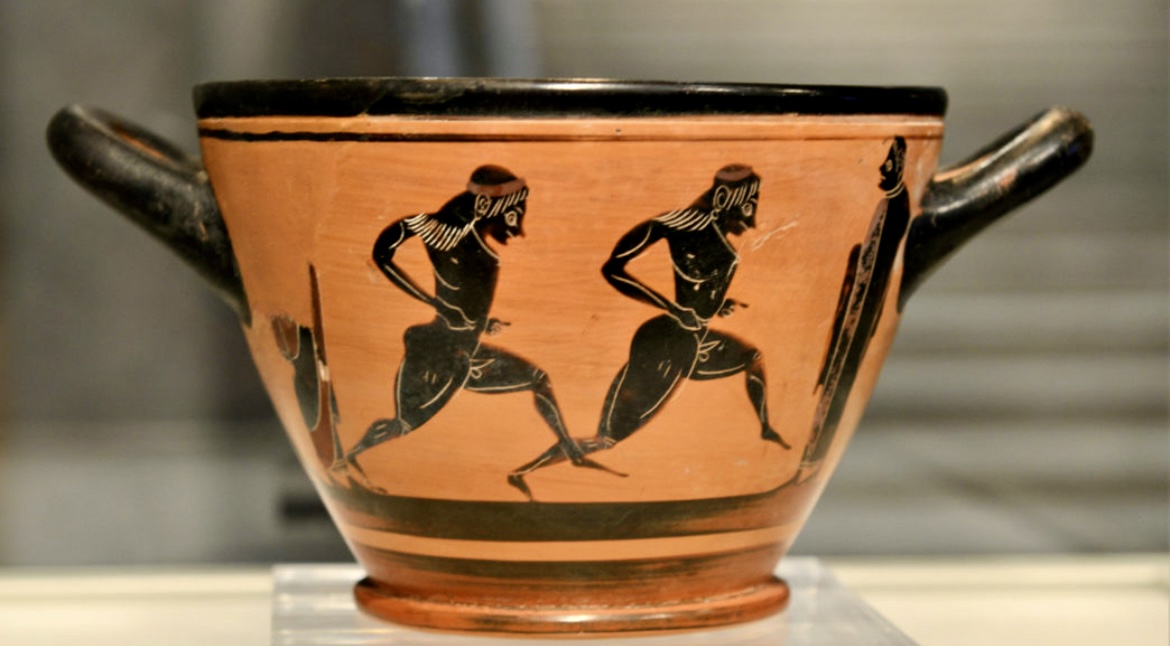
Paul compared athletic contests and athletes who trained to win a prize with Christian discipline and self-control. (1 Cor. 9:24-28).
Isthmian Game victors also received a “perishable” crown wreath made of wilted celery or pine. Paul encouraged believers to strive for lasting, eternal, imperishable crowns. (1 Cor. 9:25).
Paul also addressed disagreements, false teachers, dissension, meat offered to idols, and social discrimination between the wealthy and poor members of the church. He wanted them to know love was the controlling principle in a family of faith. (1 Cor. 8-11).
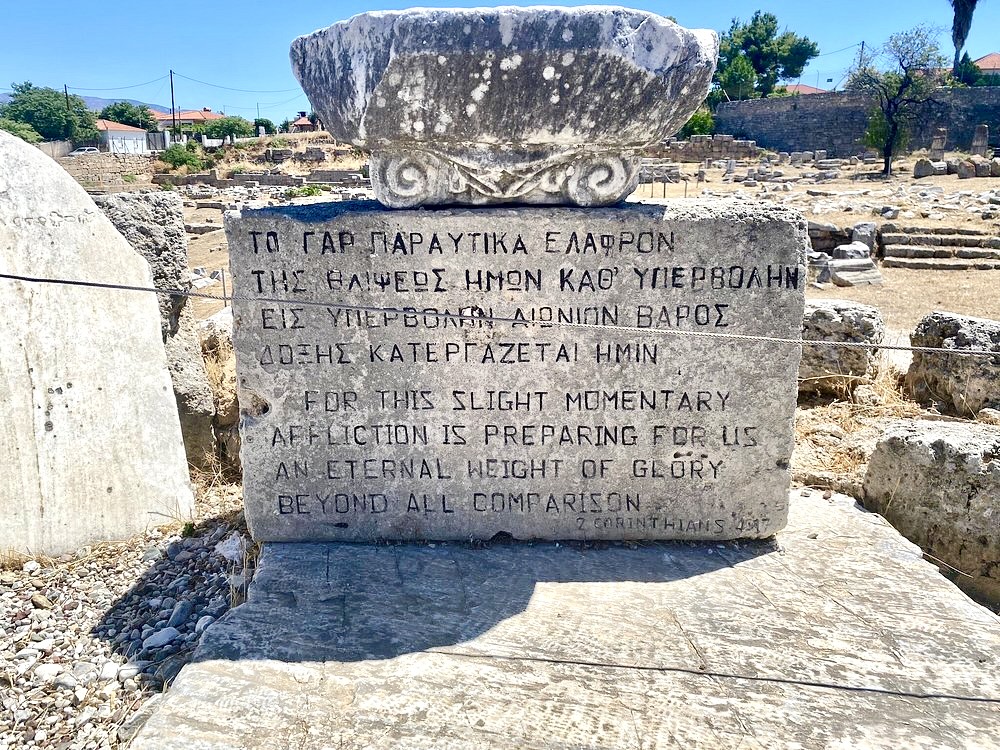
2 Corinthians 4:17
Ancient Corinth Site Visit
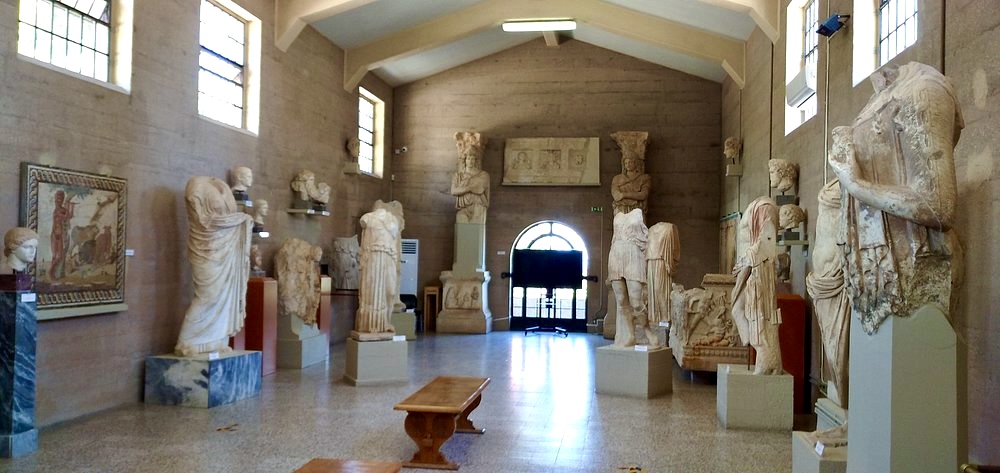
In 1986, archaeologists began excavating ancient Corinth. Because it’s such a massive site to explore, I suggest a visit to the Archaeological Museum of Ancient Corinth first. https://archaeologicalmuseums.gr
It provides history plus artifacts, statues, pottery, and treasures excavated from the site.
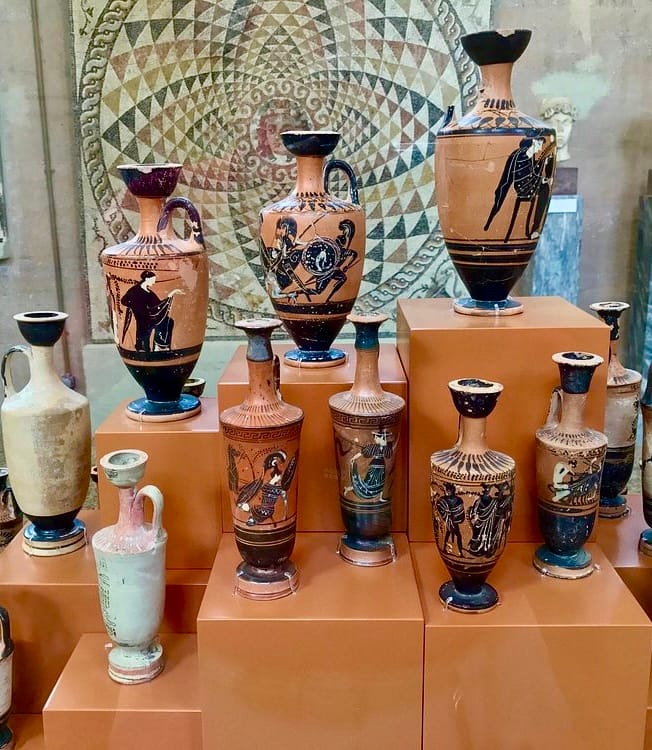
Visitors walking the ruins will find a traditional Greek agora and Roman forum with stoas and shops and huge public squares.
Two main roads run through the city: Kenchraie Road (7th century BC) ended at the eastern port. Lechaion Road (1st century BC) connected the forum to the Gulf of Corinth port.
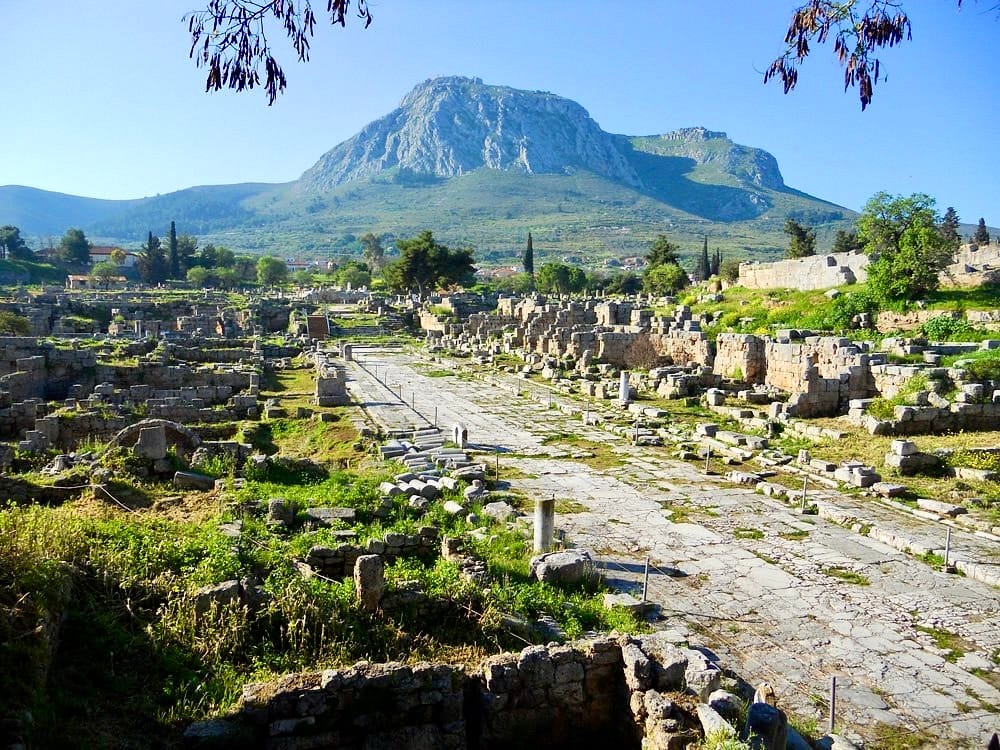
Lechaion Road (the Cardo Maximus)
Monuments and temples to Greek gods and Roman emperors are dotted here and there, along with schools, law courts, evidence of a Jewish synagogue and Byzantine churches.
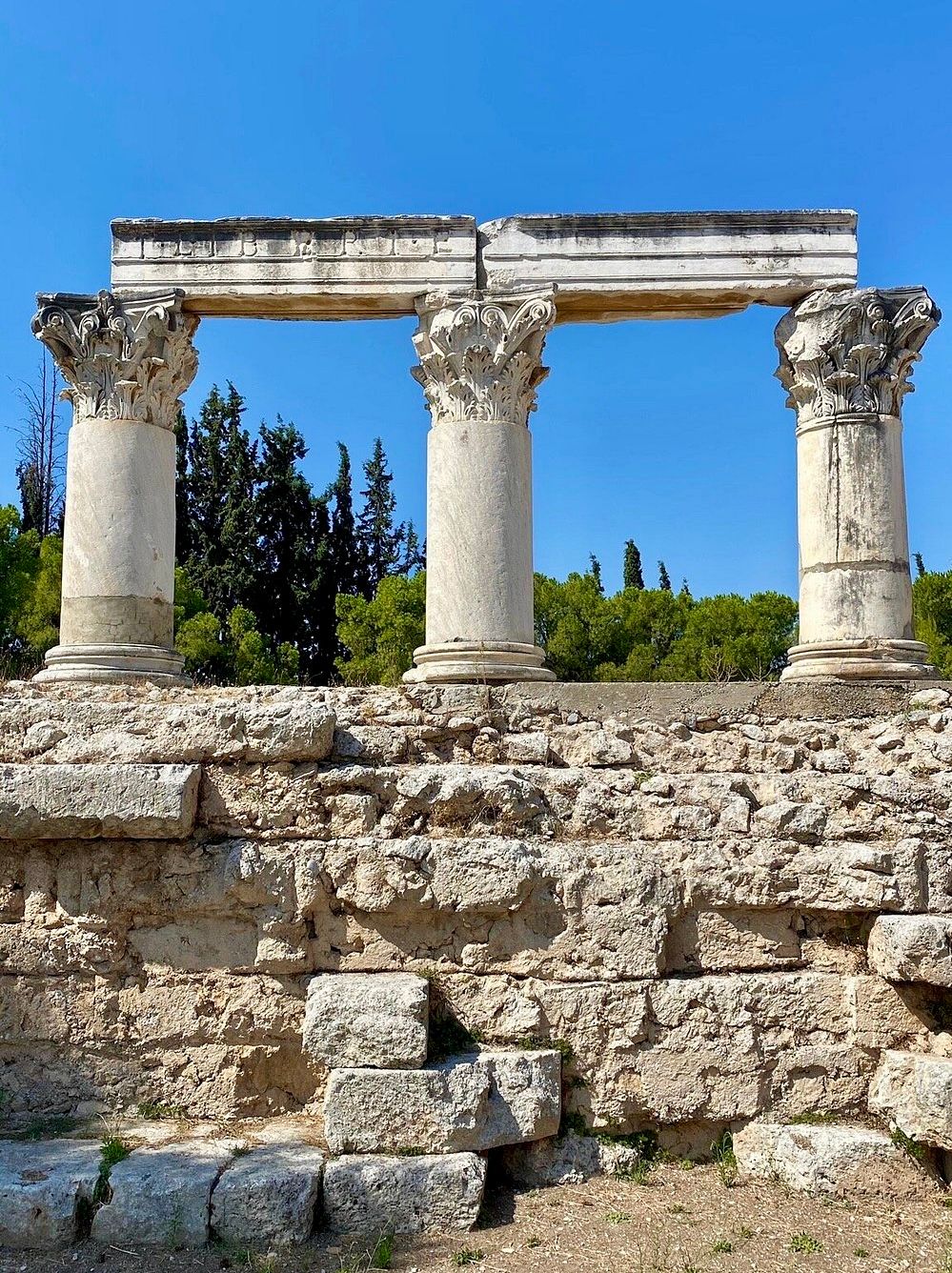
An emperor temple sporting famous Corinthian order columns and capitals.
Corinth also had a 14,000-seat theater (400 BC) eventually used for gladiator fights and mock sea battles. The smaller Odeon (1st century AD) held 3000 spectators and was used for musical events and plays.
You’ll also find statues, fountains, a race course, several bath complexes, public latrines, and even a quarry.
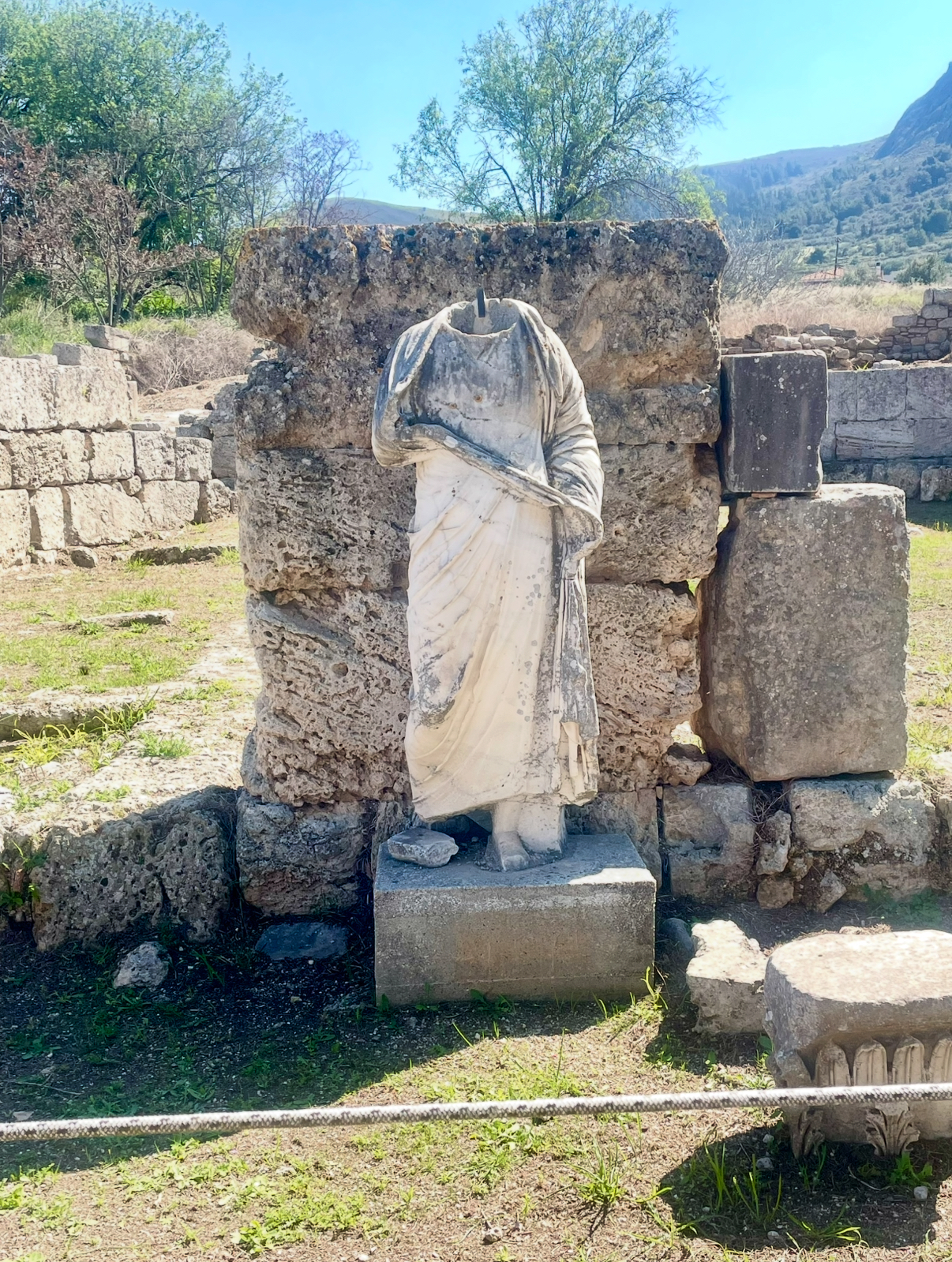
The Temple of Apollo
Corinth’s symbol, The Temple of Apollo, was originally built around 550 BC on Temple Hill. At one time, 42 monolithic columns surrounded the shrine.
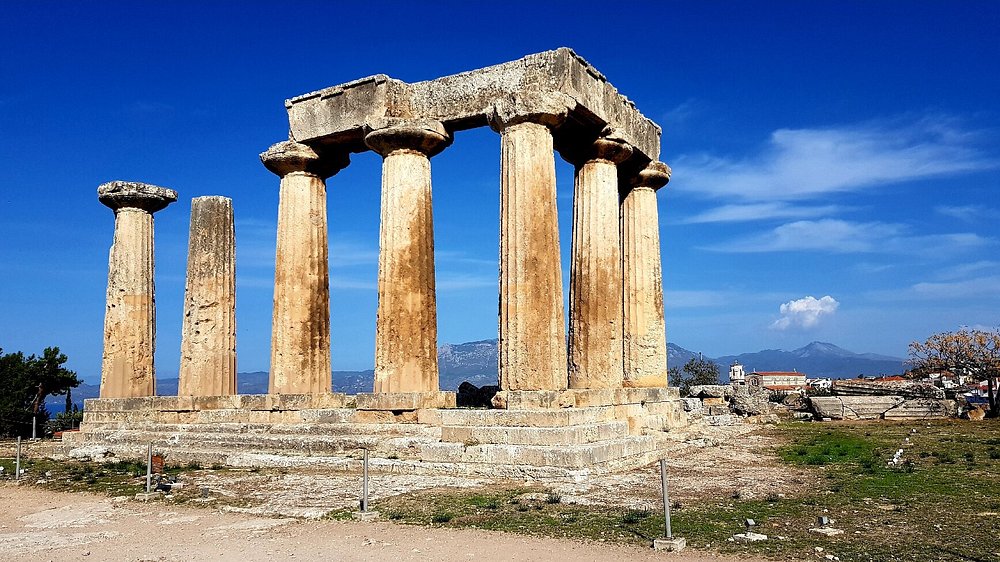
It was restored by the Romans in 44 BC, but after earthquakes, fires, and wars, only seven Doric columns remain.
The Glauke Fountain
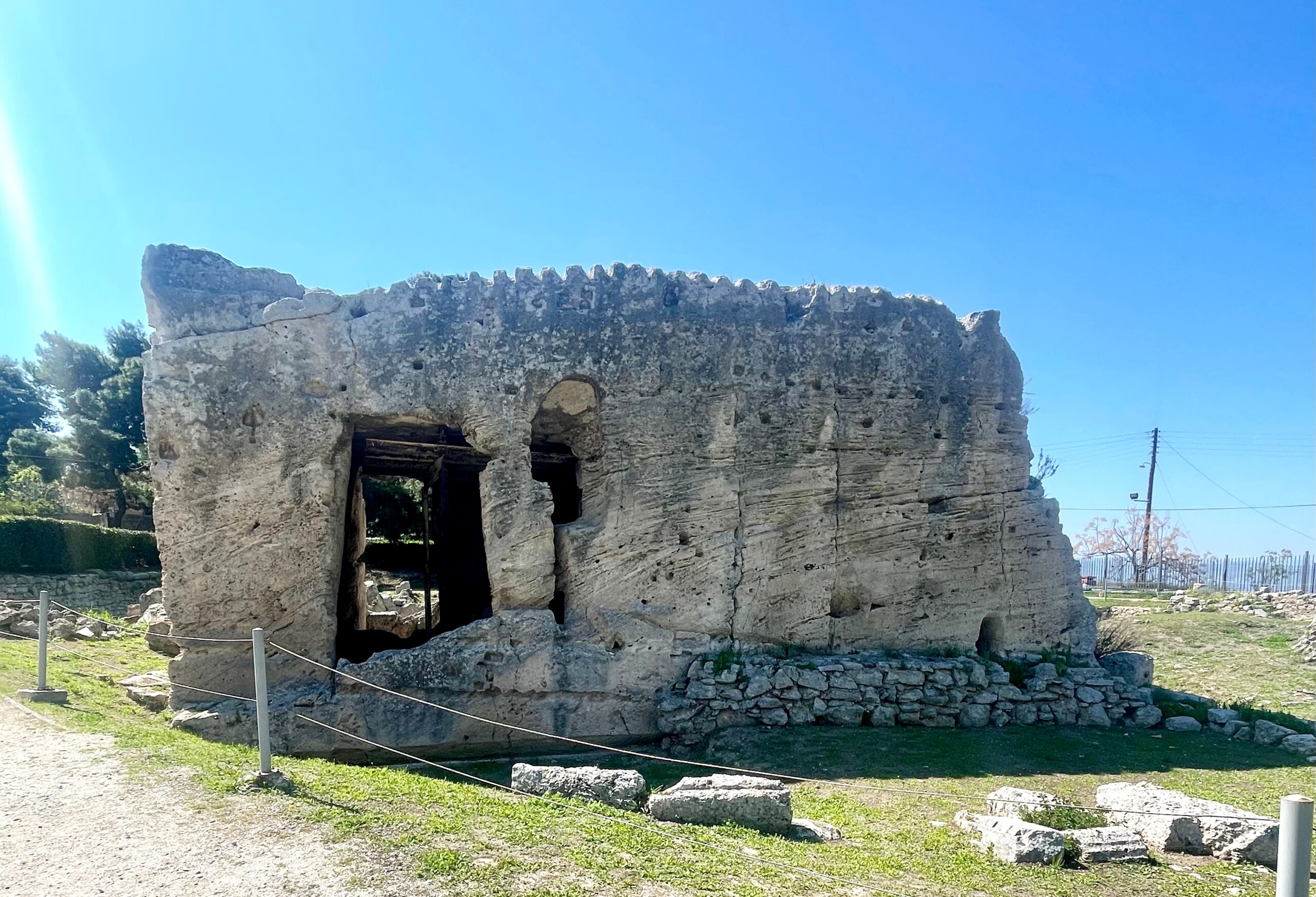
The cube-like limestone Fountain of Glauke (6th century BC) was fed by a spring from the Acrocorinth. It was also the main water source for the Temple of Apollo. The fountain is named after Glauke, the daughter of King Creon and . . . a twisted tale.
Princess Glauke was about to marry Jason, the hero of the Argonauts, who had abandoned his first wife (the witch Medea), to marry Glauke. In a fit of jealousy, Medea sent Glauke a cloak infused with poison. After putting on the cloak, Glauke jumped into the fountain in an unsuccessful attempt to stop the poison from burning her.
The Asclepion, a Shrine Devoted to Healing
Asclepius was the Greek god of healing, and this healing shrine, the Asclepion, was similar to an ancient hospital. It was built in the 5th century BC near the Spring of Lerna.
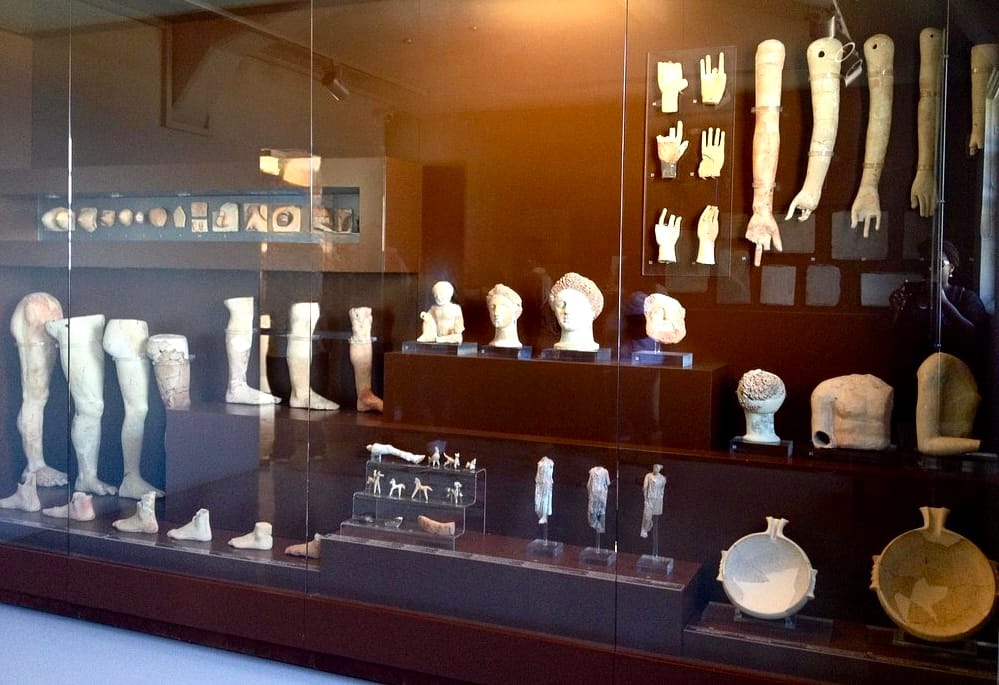
In the museum: Each person receiving treatments or seeking healing was required to offer a clay replica of the diseased or broken body part.
The Asclepion included a temple, a six-foot-deep ritual cleansing pool, and a two-story building with sleeping quarters, dining facilities, and housing for sacred serpents (oh my).
Fountain of Peirene
Corinth’s revered natural spring was said to be the favorite mythological watering-hole of Pegasus, and it still provides water today.
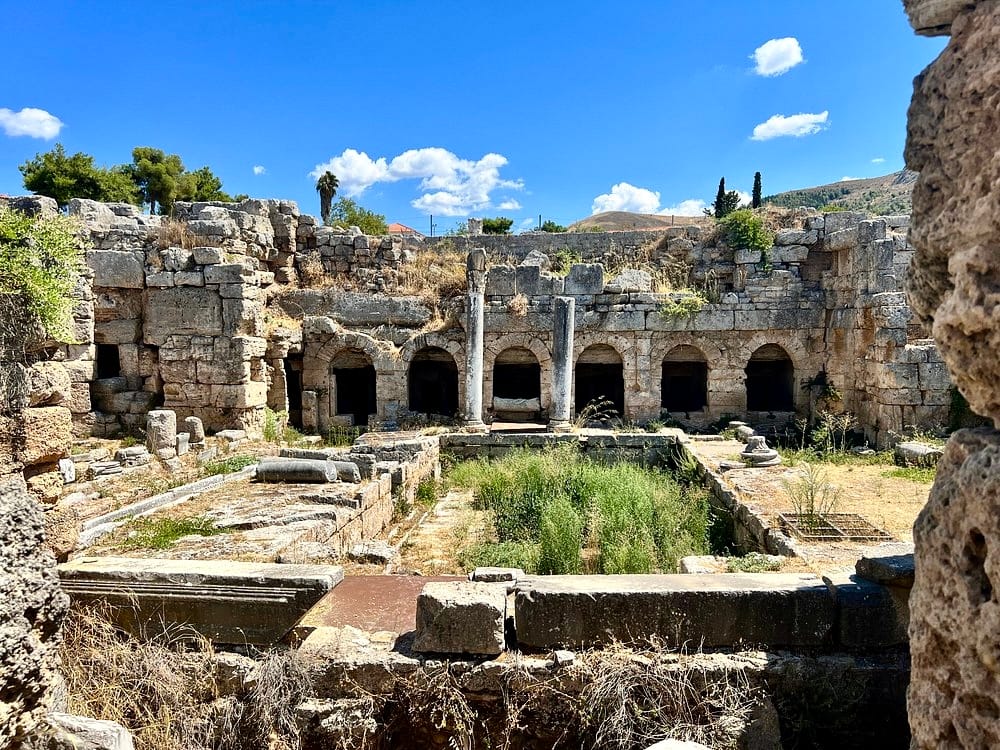
Water from four huge reservoirs flowed to the six-chamber fountain and was used by the Greeks and Romans. Romans added an open-air fountain and courtyard and painted it with vibrant colors and fish.
A Few More Tips!
Ancient Corinth is one of the best places to purchase ceramics and pottery in Greece. Just outside the site, handmade traditional reproductions are available by potters and painters who have been crafting these treasures for generations.
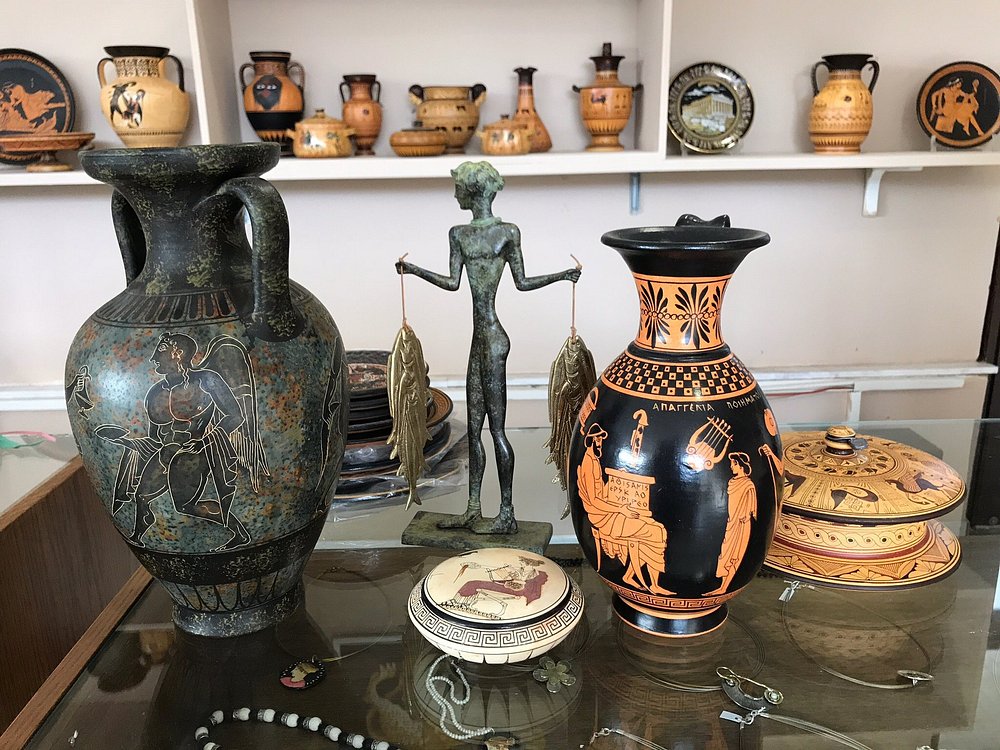
Ancient Greek Classic, Geometric and Corinthian Period styles
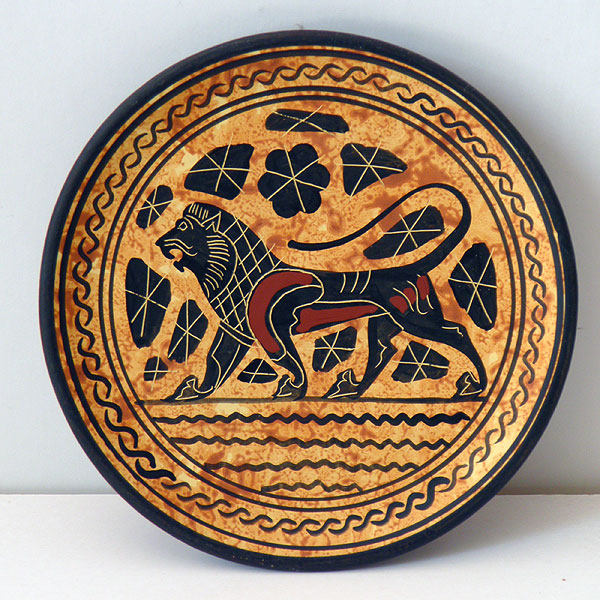
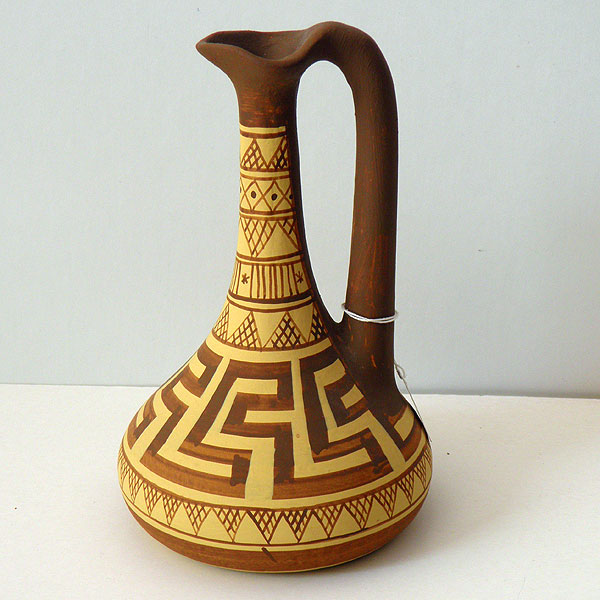
Don’t forget: if you rent a car anywhere in Greece, you’ll need to get an International Driver’s Permit (IDP) before you go. Our permits were purchased at AAA Travel. http://www.aaa.com
If you find yourself in Greece, I hope you can carve out some time for ancient Corinth. It was fascinating!
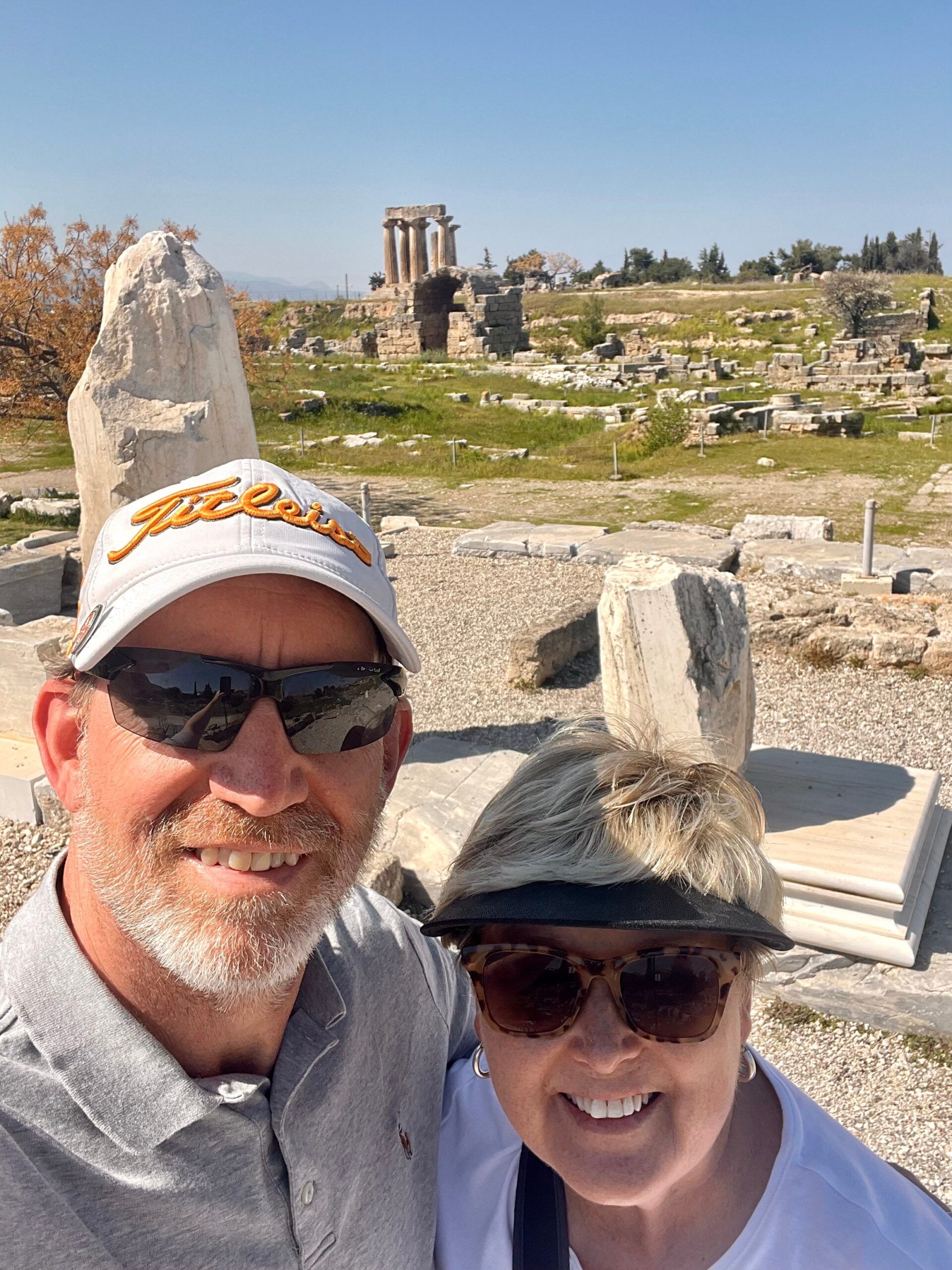
What’s next? We’ll head further south in the Greek Peloponnese to beautiful Nafplio.
Until then, keep exploring!
Check out my other Greece travel blogs:
Modern Thessaloniki – A Melting Pot of Ancient Civilizations
A Day Trip to Ancient Philippi, Greece
Meteora Monasteries – A Climb to the Top!
Magnificent Meteora – Castles in the Clouds
Delphi, Greece – It’s Still a Mystery
Olympia, Greece – The Birthplace of the Olympics
Athens, Greece – The Acropolis
Santorini, Greece – Off the Beaten Path
For all travel blogs, visit my blogsite: https://traveltipsbytami.com